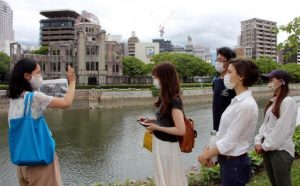Experiencing “lost neighborhoods” in Peace Park Tours focused on former Nakajima district start and end at Rest House
Jul. 2, 2020
by Kyoko Niiyama, Staff Writer
Tours of Hiroshima Peace Memorial Park, which start and end at Rest House, began on July 1. Rest House is a building that survived the atomic bombing and is located in Peace Park. Focusing on the cityscape and people’s lives within the former Nakajima district, which was wiped out in the atomic bombing and became part of Peace Park, participants can provide their thoughts about the victims. “Experience” includes exchanging ideas about peace, and is one of the features of these tours.
“It is said that about 4,400 people lived in this district,” said tour guide Haruki Yamaguchi, 27, in front of Rest House. The three participants were to visit nine locations, including the A-bomb Dome and Aioi Bridge, which was the target of the atomic bombing.
Participants were guided while being shown photos of a family taken in front of the A-bomb Dome, and of Motoyasu Bridge before the atomic bombing, that were created with computer graphics by students of Fukuyama Technical High School, located in the city of Fukuyama. Participants also had time to offer prayers looking in the direction of the hypocenter and imagining what happened on “that day.” At the end of the tour, they wrote what they hoped to cherish on pieces of paper and put them up on the wall of the second floor of Rest House.
One of the participants, Kanon Mori, 20, a university student from Sakai, Osaka, said, “Besides learning about the city before and after the atomic bombing, we shared our impressions with other participants, which was refreshing.”
The tours have been organized by Hiroden Chugoku Shimbun Travel and planned and supported by the Peace Culture Village (PCV), a nonprofit organization based in the city of Miyoshi and established by Steven Leeper, former chairperson of the Hiroshima Peace Culture Foundation. The tours are guided by four staff members of the PCV who have been working on peace activities.
A tour takes about eighty minutes. A maximum of 10 people can join a tour. English tours start at 11 a.m. and Japanese-language tours begin at 2 p.m. daily. The cost for participants aged twelve and older is 3,000 yen, for those aged eleven and younger 2,000 yen, and those younger than six are free of charge. Reservations are accepted up to and including the day of the tour. For further information, call the tourist information desk at Rest House: 082-247-6738.
(Originally published on July 2, 2020)
Utilizing CG pictures of pre-bombing cityscape, offering silent prayers
Tours of Hiroshima Peace Memorial Park, which start and end at Rest House, began on July 1. Rest House is a building that survived the atomic bombing and is located in Peace Park. Focusing on the cityscape and people’s lives within the former Nakajima district, which was wiped out in the atomic bombing and became part of Peace Park, participants can provide their thoughts about the victims. “Experience” includes exchanging ideas about peace, and is one of the features of these tours.
“It is said that about 4,400 people lived in this district,” said tour guide Haruki Yamaguchi, 27, in front of Rest House. The three participants were to visit nine locations, including the A-bomb Dome and Aioi Bridge, which was the target of the atomic bombing.
Participants were guided while being shown photos of a family taken in front of the A-bomb Dome, and of Motoyasu Bridge before the atomic bombing, that were created with computer graphics by students of Fukuyama Technical High School, located in the city of Fukuyama. Participants also had time to offer prayers looking in the direction of the hypocenter and imagining what happened on “that day.” At the end of the tour, they wrote what they hoped to cherish on pieces of paper and put them up on the wall of the second floor of Rest House.
One of the participants, Kanon Mori, 20, a university student from Sakai, Osaka, said, “Besides learning about the city before and after the atomic bombing, we shared our impressions with other participants, which was refreshing.”
The tours have been organized by Hiroden Chugoku Shimbun Travel and planned and supported by the Peace Culture Village (PCV), a nonprofit organization based in the city of Miyoshi and established by Steven Leeper, former chairperson of the Hiroshima Peace Culture Foundation. The tours are guided by four staff members of the PCV who have been working on peace activities.
A tour takes about eighty minutes. A maximum of 10 people can join a tour. English tours start at 11 a.m. and Japanese-language tours begin at 2 p.m. daily. The cost for participants aged twelve and older is 3,000 yen, for those aged eleven and younger 2,000 yen, and those younger than six are free of charge. Reservations are accepted up to and including the day of the tour. For further information, call the tourist information desk at Rest House: 082-247-6738.
(Originally published on July 2, 2020)








